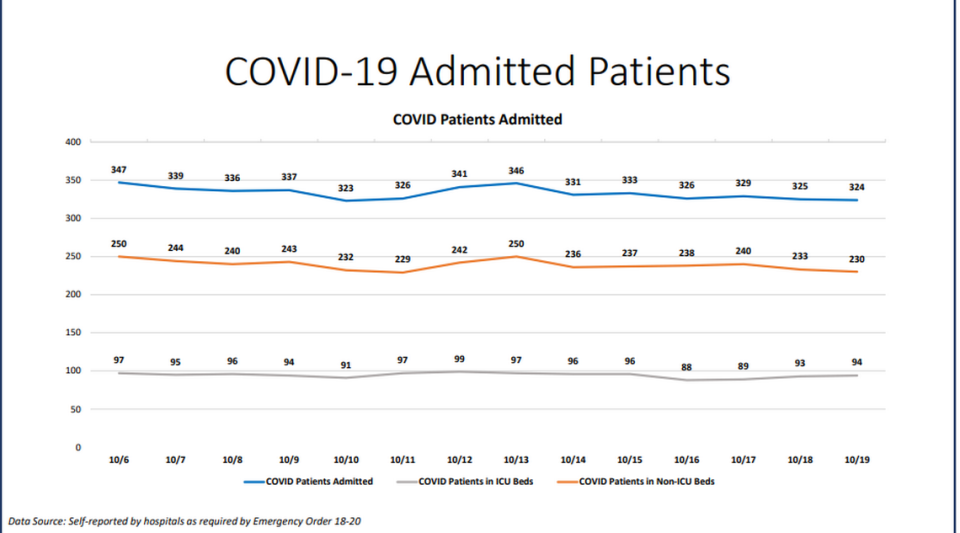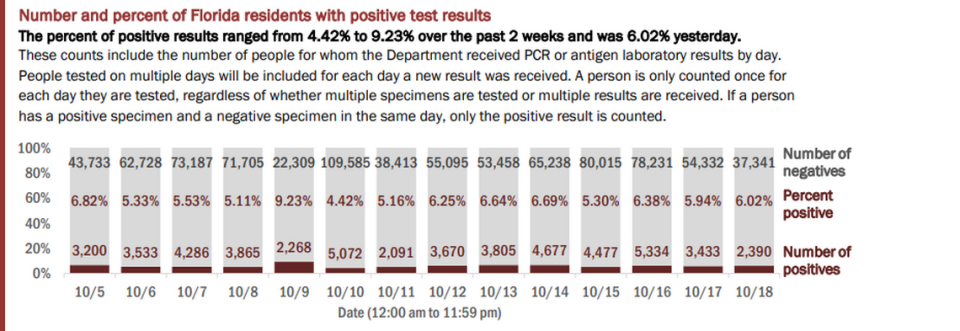COVID-19 death toll hits 16,000 for Florida residents as state reports 1,707 new cases
Florida’s Department of Health on Monday confirmed 1,707 additional cases of COVID-19 as Johns Hopkins University reported that the world had surpassed 40 million confirmed cases of the disease.
The state now has 756,727 confirmed cases. Also, 54 resident deaths were announced, bringing the resident death toll to 16,021.
There were no new non-resident deaths reported, leaving the non-resident toll at 201.
Florida has seen a slight increase in newly confirmed cases this month. Mondays usually see a lower case count compared to other days in the week because fewer people work in labs and enter data on the weekends. And while this Monday is the lowest single day count recorded since last week, it is the the biggest increase for a Monday in a month.
Florida’s percent positivity for people who tested positive for the first time (excluding retests) also saw a slight uptick, increasing from 4.66% to 4.86%.
Here’s what you need to know:
Listen to today's top stories from the Miami Herald:
Subscribe: Apple Podcasts | Spotify | Amazon Alexa | Google Assistant | More options
Confirmed COVID-19 cases in South Florida
Note: The Florida Department of Health says that each county’s percent positivity for new cases (people who tested positive for the first time) does not include retests (people who have tested positive once and are being tested for a second time).
▪ Miami-Dade County reported 372 additional confirmed cases of COVID-19 and seven new deaths, according to Florida’s Department of Health. The county now has 178,726 confirmed cases and 3,547 deaths. Percent positivity for new cases decreased from 4.38% to 4.15%. The 14-day percent positivity average was 4.62%, according to Miami-Dade County’s New Normal Dashboard.
▪ Broward County reported 170 additional confirmed cases of the disease and five new deaths. The county has a known total of 81,277 cases and 1,515 deaths. Percent positivity for new cases decreased from 4.71% to 3.76%.
▪ Palm Beach County saw 57 additional confirmed cases and seven new deaths. The county now has 49,068 confirmed cases and 1,497 deaths. Percent positivity for new cases decreased from 3.97% to 2.74%.
▪ Monroe County confirmed 31 additional cases and no new deaths. The county has a known total of 2,080 cases and 25 deaths. Percent positivity for new cases rose from 5.52% to 8.80%.
COVID-19 hospitalizations in Florida
One of the tools that officials rely on to determine whether the coronavirus situation is improving in the state is hospitalization data. Unlike testing, which might be limited or take days to report results, hospitalizations can help give officials a real-time snapshot of how many people are severely ill with COVID-19.
The Florida Agency for Health Care Administration reports the number of patients hospitalized statewide with a “primary diagnosis of COVID.” The data, which is updated at least every hour, does not distinguish between the number of COVID-19 patients in hospital intensive care units and those in acute-care beds, which require less attention from nurses.
Previously, the state was providing only the total number of hospitalizations in its statewide and county-level data. Miami-Dade was an exception, with hospitals self-reporting a number of key metrics, including hospitalizations, to the county, which has made this data public for several months.
As of 2 p.m. Monday, there were 2,057 COVID-19 patients admitted into hospitals throughout the state, according to the Florida Agency for Health Care Administration dashboard. This is a significant decrease from early August, when more than 5,000 COVID-19 patients were admitted into hospitals throughout the state.
Of Monday’s hospitalizations, 265 were in Miami-Dade, 188 in Broward, 99 in Palm Beach and seven in Monroe counties, according to the agency.
Florida’s current hospitalization data does not always match the hospitalization data reported in Miami-Dade’s “New Normal” dashboard. Officials say this could be for a number of reasons, including the frequency of daily updates.
On Monday, Miami-Dade hospitalizations for COVID-19 complications decreased by one. There are now 324 people hospitalized, according to Miami-Dade County’s “New Normal” dashboard. According to Monday’s data, 34 people were discharged and 28 people were admitted.

The state has had a total of 47,125 Florida residents hospitalized for COVID-19-related complications, according to Florida’s COVID-19 Data and Surveillance Dashboard.
COVID-19 Testing in Florida
Testing in Florida has seen steady growth since the COVID-19 crisis began.
Testing, like hospitalizations, helps officials determine the virus’ progress and plays a role in deciding whether it is safe to lift stay-at-home orders and loosen restrictions.
Epidemiologists then use the testing data to create a positivity rate. The rate helps them determine if a rise in cases is because of an increase in testing or if it means there’s increased transmission of the virus in the community.
On Monday, Florida’s Department of Health reported the results of 39,731 people tested on Sunday. The positivity rate of new cases (people who tested positive for the first time) increased from 4.66% to 4.86%.

If retests are included — people who have tested positive once and are being tested for a second time — the positivity rate increased from 5.94% to 6.02%, according to the report.

